Tamil Nadu Government’s Department of Museum has been celebrating UNESCO’s recognition of Chennai as ‘a Creative City for Music” with a series of events. For last two days, an edutainment series is happening at the Museum Theatre, titled aptly as “Iyal Isai Museum”. I attended the morning session today, which had brilliant talks by experts – got to learn so much about fields I had no knowledge.
Dr Swanamalya Ganesh talked about Visual and Performing Arts (~ Dance) of 17th Century Tamil Nadu. She explained how the art form has developed over the centuries in Tamil Nadu with ample examples from sculptures and songs. Highlighted on how Bharathanatyam was an inclusive art form, representing all walks of life – a contrast to what it has become now. She treated the audience to a brief performance to a centuries-old English poem written to celebrate Tamil dance form.
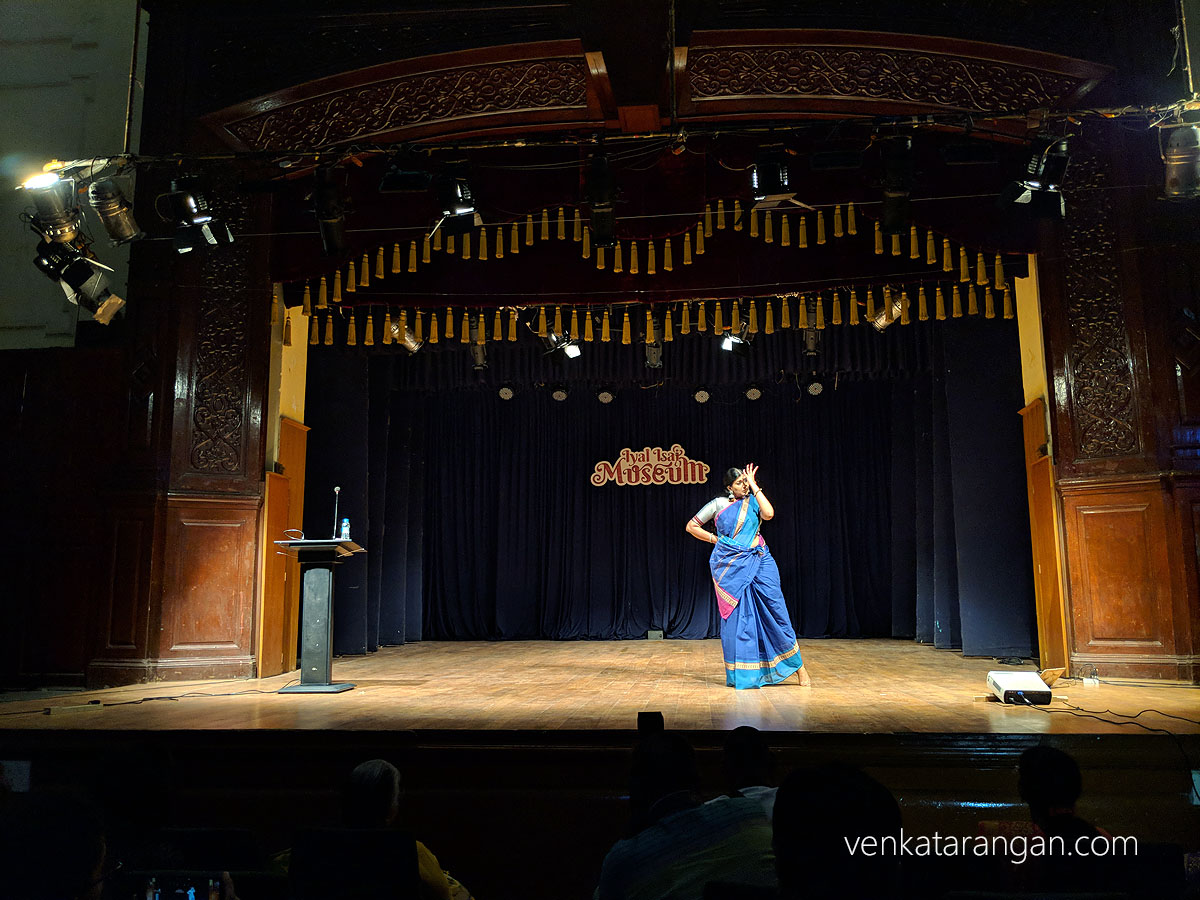
Dr Swanamalya Ganesh performing for a 17/18th Century English song on Tamil Dance
Thiru N Mammuthu, Musicologist talked on பழந்தமிழர் இசைக் கருவிகள். An accomplished expert in the field, he initially seemed to veer off from the topic to explain the origin of the word Dravidian (Prakrit Damela to Sanskrit Dravida to Tamil) and historical happenings. Later, I understood his objective was to paint the whole canvas – History, People, Culture, Language, Region – before connecting them all to the music and its heritage that has a symbiotic connection across all 5 Southern regions (Tamil Nadu, Kerala, Karnataka, Andhra, Tulu) and even across India. Any research or PhD study on old Tamil culture or Music will be complete only if it studies the region as a whole. I was able to note down the following:
- Mysuru in old Tamil was எருமையூர்
- நன்னன் என்ற மன்னன் ஆண்ட ஊர், எழில் மலை (A mountain in Tulu land). Also called கொங்கன நாடு
- பெரிய தெய்வங்களை விட எண்ணிக்கையில் சிறு தெய்வங்களுக்கான கோயில்கள் தான் அதிகம். கூறிப்பாக தாய் தெய்வங்கள்/அம்மன் கோயில்கள் தான் இந்தியாவில் / தமிழ்நாட்டில் அதிகம். முருகர், சிவன், விஷ்ணு தமிழ்நாட்டிற்கு வந்தது பின்பு தான்
- யாழ் என்றால் ராகம்
- பறை என்றால் தாளம்
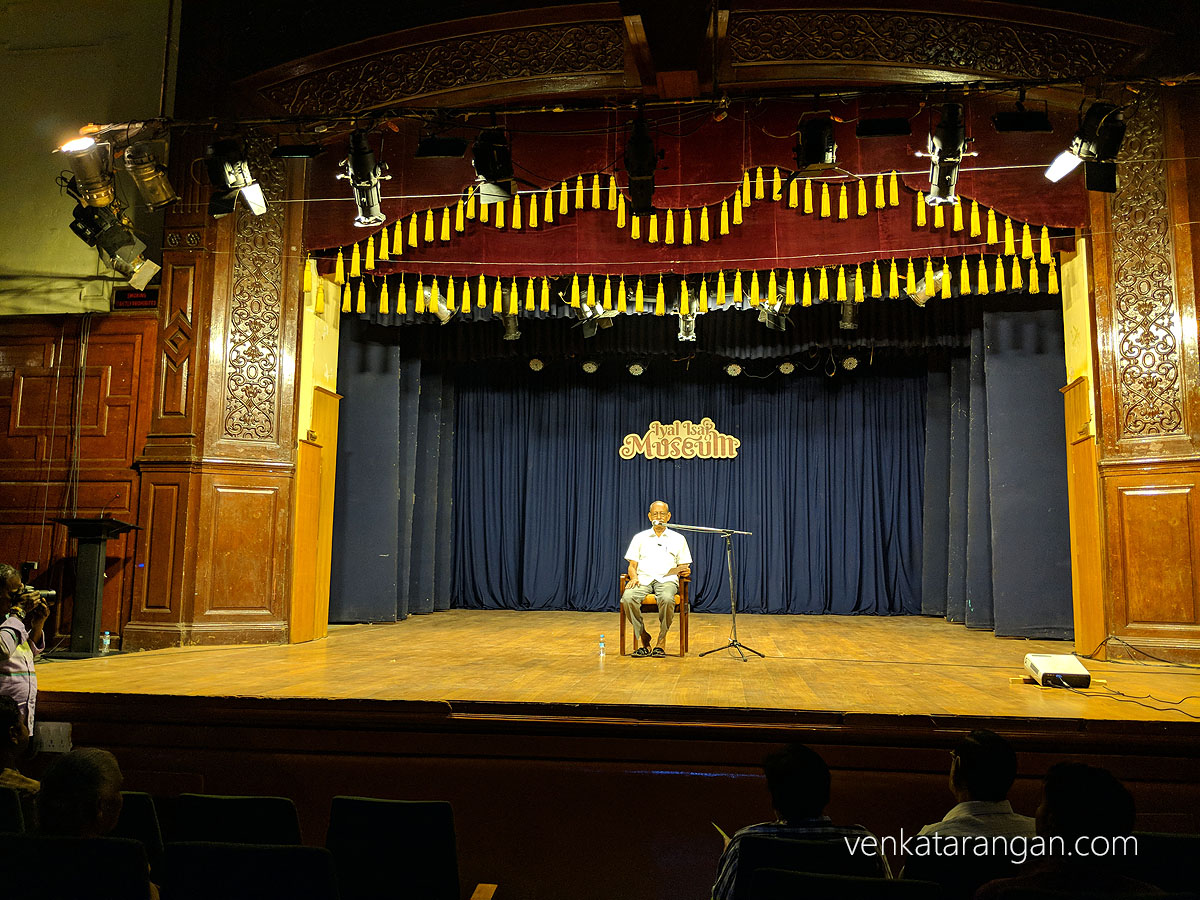
Thiru N Mammuthu, Musicologist
Dr Santhosh Babu delivered an inspiring talk on his experience of doing digital transformation at Poompuhar, and on how technology can enhance the museum’s visitor experience onsite and online. He shared his experiences of visiting New York Met Museum to London Museum. He explained how technologies like iBeacon, AR can compliment onsite visits to know more the exhibits and how VR can compliment a virtual visit. As Chairman and Managing Director of Poompuhar (Tamil Nadu Handicrafts Development Corporation), he made a business proposal to Ms Kavitha Ramu (Director, Museums) – to sell models of exhibits in Egmore Museum to visitors by using 3D printing technology.
Video recording of the talk (updated 12/March/2018)
“Transformational changes can be only done by leveraging/with a layer of technology. No amount of management technique alone will help“

Director of Museums, Ms Kavitha Ramu (I.A.S) inviting to stage Dr Santhosh Babu (I.A.S)
Next was Prof. Madhusudhanan Kalaichelvan (Associate Professor of Architecture) delivering a mesmerising talk on “Nataraja – The Philosopher and His Philosophy”. I have seen statues of Lord Nataraja many times, have read a bit about the significance, but Madhusudhanan revealed so much about it, including the secret of Chidambaram.
- Thiruvalangadu (திருவாலங்காடு) Nataraja is the best of the best bronze sculptures of Nataraja anywhere in the world and is now on display at the Chennai Museum
- Seeyamangalam is the earliest form of Nataraj
- Nataraja has recently gone to CERN lab in Europe
- Auguste Rodin considered the ‘father of modern sculpture’ has said “perfect expression of rhythmic movement in the world“
- Silent Guru form of Lord Siva is Dhakshinamoorthy
- Chidambaram koil has five concentric corridors, representing the path humans have to take in their inner quest
- In Tamil we have five elements, in the direction of creation it goes like ஆகாயம் -> காற்று -> நெருப்பு -> நீர் -> நிலம், and in the reverse when it is destruction
- Nataraja symbolises Creation (ஆக்கம்), Destruction (அழித்தல்), Sustenance (காத்தல்), Hiding (மறைத்தல்) and Blessing (அருள்)
- The Right Hand Udukkai is to show Creation happening from the rhythm (music), Left Hand he is holding fire to show of (graceful) Destruction, and he stands on top of a daemon Apasmara which is a depiction of Ignorance
He ended with a poem of Kalidasa from Raghuvamsha, which has a meaning of “I pray parents of the world, Lord Shiva and Mother Parvathi, who are inseparable as speech and its meaning to gain knowledge”.
Vagarthaviva sampriktau vagarthah pratipattaye | Jagatah pitarau vande parvathiparameshwarau ||
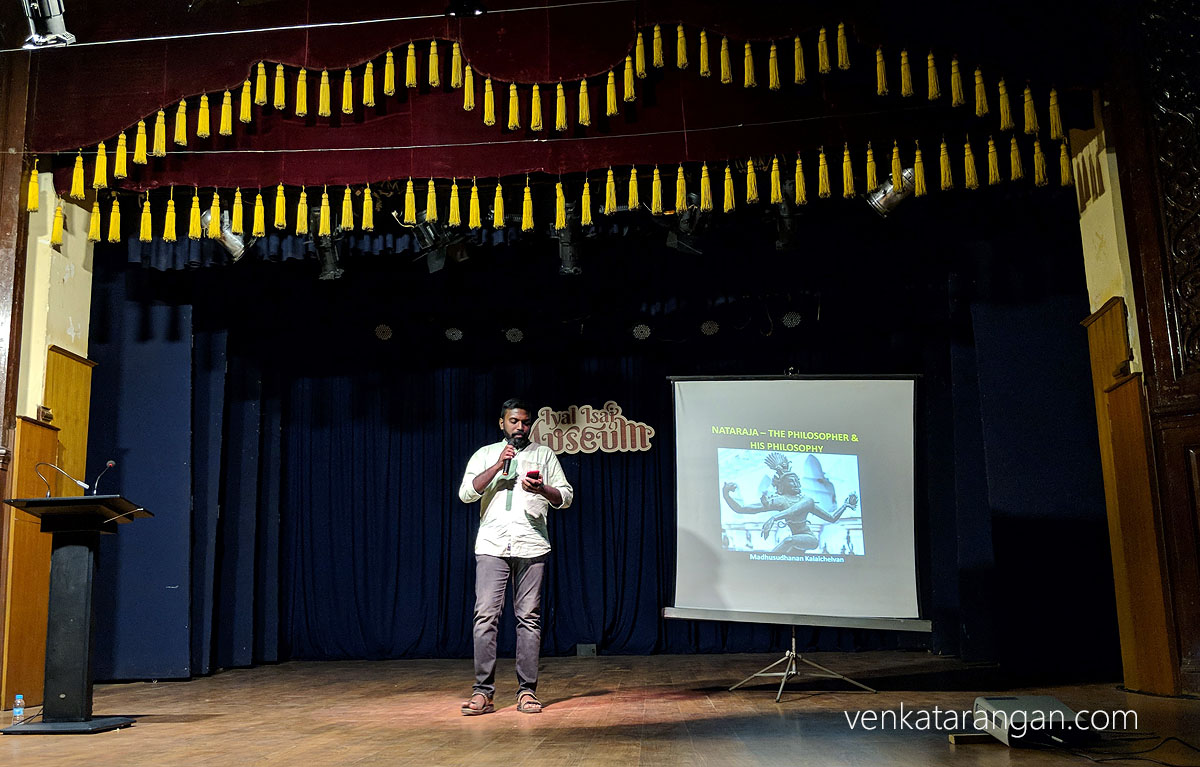
Prof. Madhusudhanan Kalaichelvan “Nataraja – The Philosopher and His Philosophy”


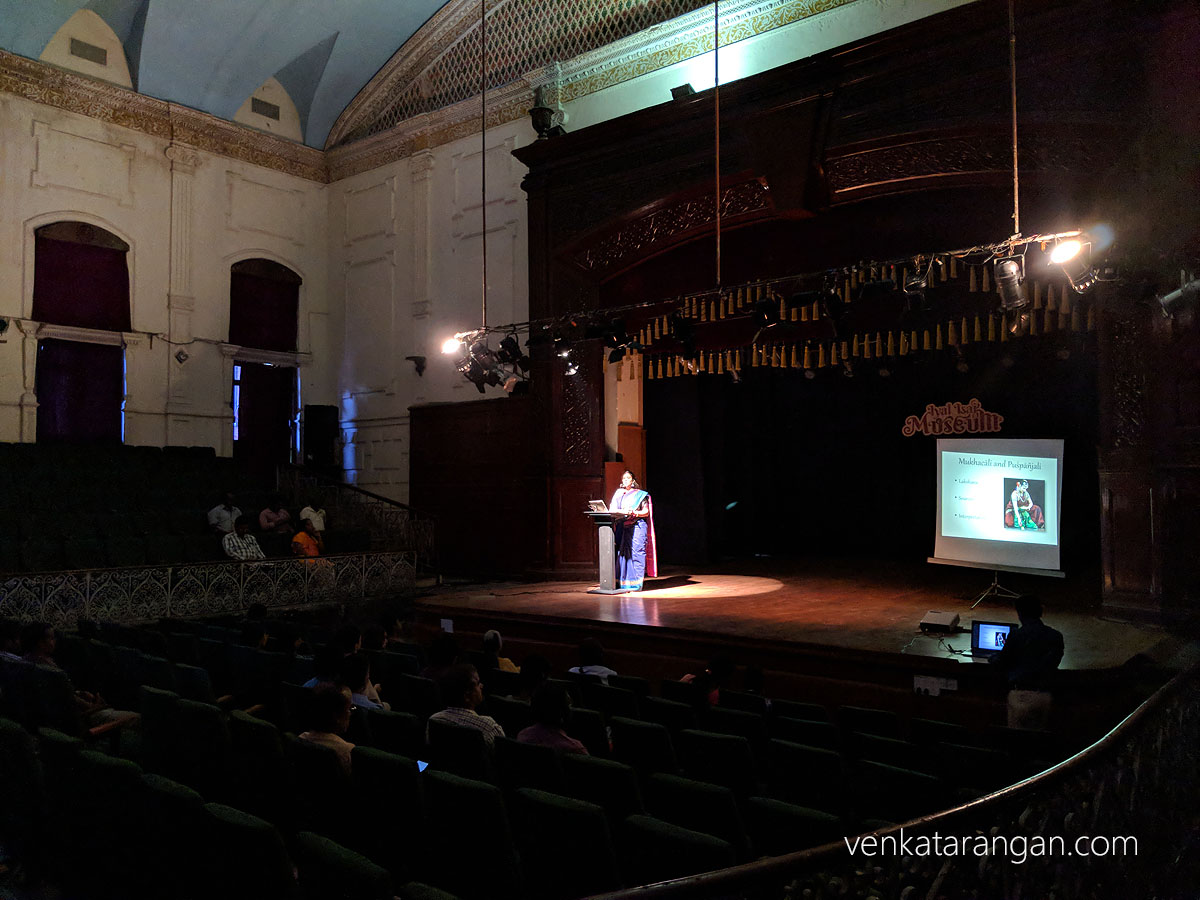
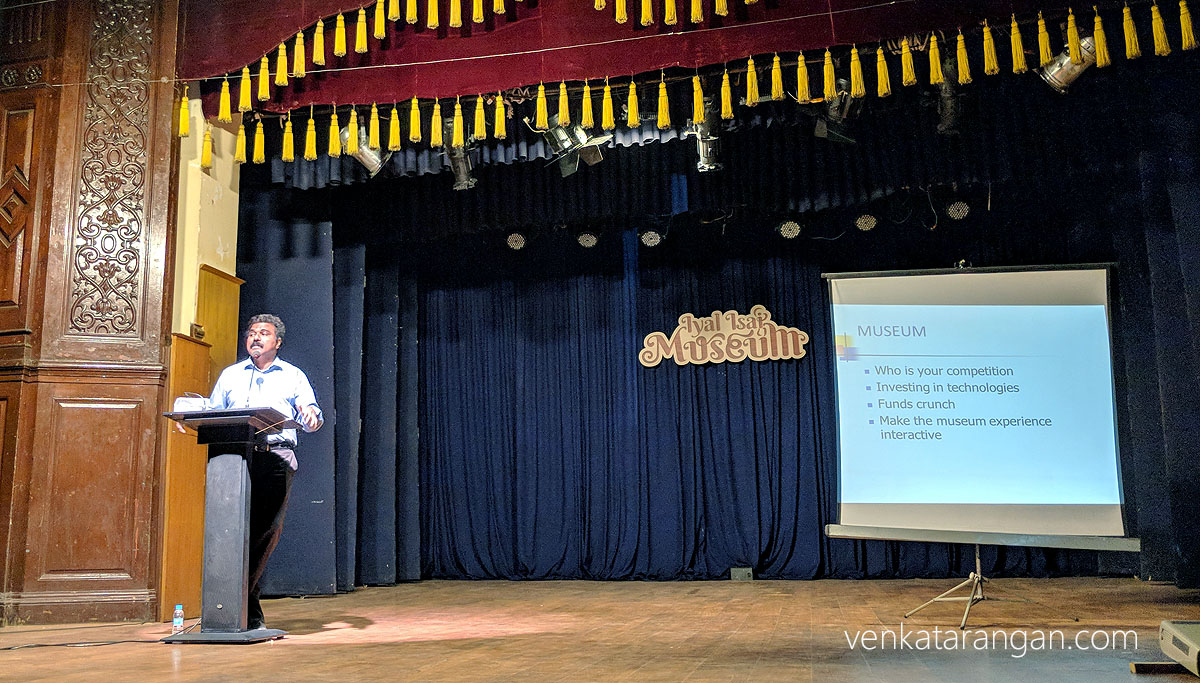
Comments